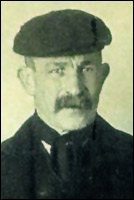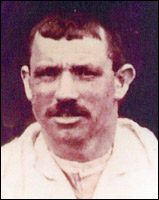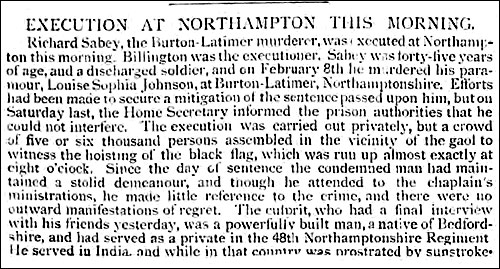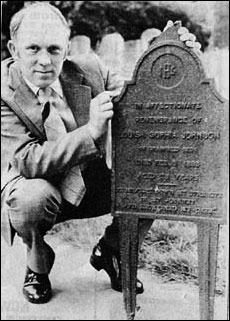|
Louisa's brother-in-law, who had been warned by his daughter that she had gone off with a man, then arrived at the scene and asked that her body should not be taken back to the cottage as his wife was very ill and the sight of Louisa would be the death of her. A cart was brought from the mill and Louisa's body was taken to The Red Cow Inn where the inquest took place on two days later. Sabey had made his way to Finedon, followed by Willie Evans and several other men, where he later gave himself up to a policeman at the ‘Gate Inn’.
 |
Left - John Evans
Right - Willie Evans
|
|
 |
Louisa was buried at
4.00 pm
on
Saturday 11th February 1893
when the streets from the Red Cow to the Church were lined with people as the glass sided shillibeer and the mourners made their way to the Church. Louisa's sister Mary was still too ill to attend the funeral.
On the day after the funeral, both Burton Latimer and Finedon railway stations were extremely busy as people from the villages and towns around flocked to see the spot where the murder had taken place and some of the bloodstained stones were removed as souvenirs by the visitors.
Richard Sabey, who never denied the murder, was tried and found guilty of murder at Northampton Assizes on 29th June and hanged on
18th July 1893
at Northampton Gaol.
 |
|
Sabey's execution as reported in the Pall Mall Gazette
|
There is a legend, which is perpetuated by many, that says Louisa ran back to Ise Brook Cottage and died in a bedroom there and that her ghost still haunts the place. It makes a good story but the fact remains that she never returned, alive or dead, to Isebrook Cottage.
 |
1982
Chairman of the Parochial Council Brian Mutlow
holds Lousia Johnson's grave marker, which had
been tampered with in a spate of vandalism
which took place that year.
The marker was purchased as a result of
generous public donations
|
|
The Inquest into the Death of Louisa Johnson
Held at the Red Cow Inn
Friday 10th February 1893
The Coroner
Mr. J.T. Parker (
Kettering
)
The Jury
Mr. W.J. Gross, Foreman [Farmer]
Mr. Charles Barlow [Quarry owner, Grocer, Farmer]
Mr. Ernest E. James [Draper & Grocer]
Mr. James E. Nutt [Clerk to Parish Council]
Mr. Samuel Maycock [Farmer]
Mr. Frederick Downing [Shoe maker]
Mr. John Cooper [Baker]
Mr. John Ball [Builder]
Mr. Henry Ayres [Butcher, Grocer, Beer seller]
Mr. Thomas Ambler [Coal Merchant]
Mr. Stephen Blake [Blacksmith]
Mr. James Talbott [Baker]
Mr. Frederick Miller [Landlord, Thatcher’s Arms]
Mr. Philip Andrew Shrive [Shoe rivetter]
Mr. William Hobbs [Tailor]
Mr. Frederick W. Dicks [Tailor]
Mr. Charles Loveday [Saddler]
Mr. Frederick Norton [Baker]
Witnesses
(In order of appearance)
Thomas Frederick Wright, brother-in-law
Edward William Partridge, baker, Finedon
Joseph Robinson, manager at J.L Wright’s Flour Mill
Mrs. Burr, driver of trap
P.C. William Judge, Finedon
Kate Wright, 11 yrs, daughter of Thomas F Wright
Miss Abigail Panter,
Burton
Latimer
Will Evans, Ironstone labourer, Brickyard Row, B.L.
John Evans, Ironstone labourer, Burton Latimer
James Burley, Ironstone labourer, Burton Latimer
Owen Watts, Ironstone labourer, Burton Latimer
Dr. Herbert Burland, Surgeon, Finedon
William Laycock, Manager of Liverpool cutlery shop
P.C. George W. Currin,
Burton
Latimer
Sgt. George Grant,
Liverpool
Police
|